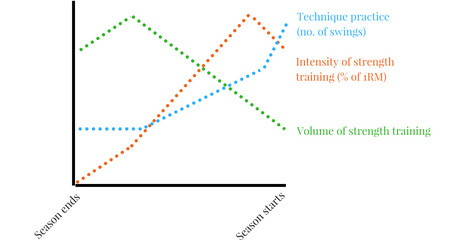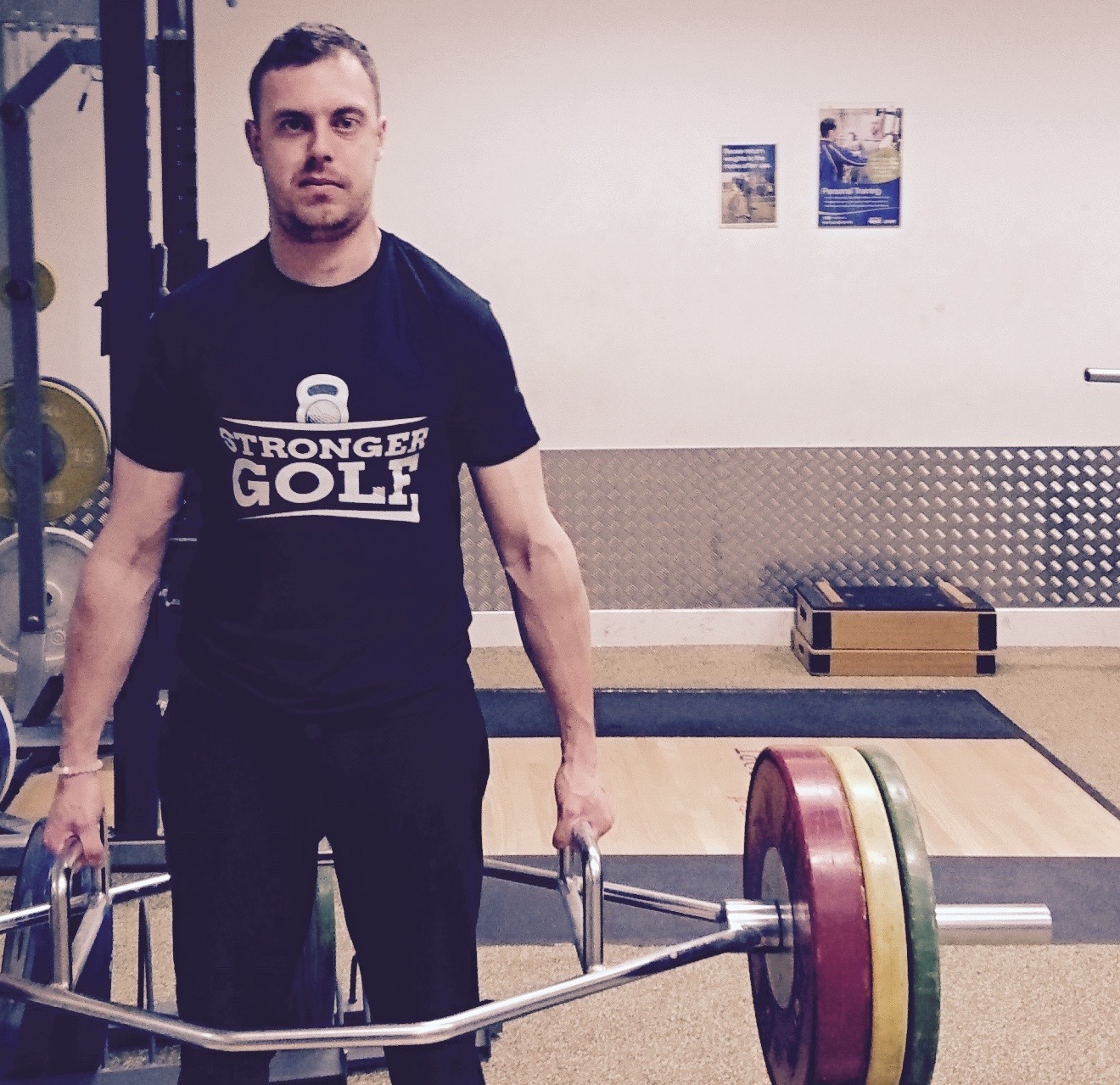IMPROVE MY GAME
Articles
A Practical Guide to Off-Season Periodization for Golf Fitness
[ICYMI: We've confirmed our first few TPI Level 1 seminars of 2017, including Orlando, DC, Cleveland and Birmingham (UK)]
Simple Periodization For The Off-Season
Periodization might be the most over studied subject in the training world. Tens of thousands of pages have been written detailing the complexities of microcycles and mesocycles. Unfortunately, this has lead to periodization being a pretty confusing subject for most golfers, when in fact it should be a fairly simple concept.
A primer on periodization
Periodization simply means having a plan. The purpose of any strength training method should be to prepare athletes for competition; to achieve this the athlete need to be exposed to a periodization program. As the preeminent author on periodization Tudor Bomba states:
“Performance only occurs because you plan for it.”
Periodization is the process of breaking your training into specific cycles or phases in order to control the volume and intensity. By varying your training in phases, you control your training adaptations and fitness to achieve peak performance or better health on a more predictable basis. Periodization must be based on the specific physiological requirements of the given sport and again must result in the highest development of power, power endurance or muscular endurance depending on the needs of the sport.
All periodization programs begin with a general anatomical adaptation phase that prepares the body for the phases that follow. One of the goals of periodization is to bring the athlete to the highest possible level of maximum strength within the annual plan so that gains in strength can become gains in power, power endurance or muscular endurance depending on the needs of the sport. Training should therefore go from general to specific.
As stated by strength and conditioning guru Charles Poliquin, “phases of high volume (accumulation, extensive loading), high intensity (intensification, intensive loading) and unloading should be modulated within the program.” Whilst that might sound complicated its actually simple - Higher volume, lower load periods and higher intensity, lower volume periods should be utilized within the program.
Dan John, another giant in the field, recommended between 15 and 25 reps for major exercises. That means you have the choice of accumulating volume with 3 sets of 8 (24 total reps) or exercising more intensely with 5 sets of 3 (15 total reps). This makes things relatively simple when you consider for stability and endurance we train with higher reps, lower for strength with the lowest reps for training power.
Putting it together for the golf athlete
Developing power, speed and acceleration is plainly essential for golf. The ultimate goal should therefore be to develop these qualities to there maximum for the start of the season. However, this can only be achieved once a suitable foundation of strength and stability/mobility is built.
Golfers should prioritize developing stability (and mobility where needed), followed by building maximal strength in general movement patterns and then look to work on exercises that develop power, acceleration and speed. When developing power, exercises that replicate the planes of motion of the golf swing (i.e. exercises that mimic the golf swing) can be added to develop power and acceleration in these planes, however these should only be added to complement once a general strength base has been built.
For these reasons my off-season golf programs use a linear block periodization set up. Linear block periodization is where training blocks are arranged to allow for a linear decrease in training volume and a resultant increase in intensity (training load as percentage of 1RM).

This method allows an overall development of multiple qualities that are important to performance, as well as a way of being able to focus more on the general overall training effect of strength development, which is hugely advantageous for the average golfer.
The major criticism of linear block periodization is that by dividing training into blocks that focus on specific fitness qualities - strength, power, mobility, etc, you lose some of that quality in subsequent phases. For example, strength will peak after the strength phase but will diminish somewhat after a power phase, as the volume of strength work will have been reduced in this block.
My feelings are that, whilst mobility is typically a fairly transient quality and regular work is needed, once built it can be maintained with low training volume and intensity that doesn’t tax recovery too much. Further, strength is not the ultimate goal in a golf fitness program rather the road to power and speed so losing some top end strength as we move towards the season, providing a good base has been built, is not a huge issue.
Note: Research has shown combining linear non-linear periodization models in the annual training cycle is more effective than linear, particularly where a sport has a long, intense competition season (this is definitely true of golf) and, in that period, non-linear periodization is, arguably, the only logical choice. Therefore, in-season and with more advanced athletes we will utilise a non-linear or undulating periodization approach.
Example periodization
Our programs typically follow a simple periodization cycle of sets of 8 to 10 (accumulation phase with mobility/strength focus) followed by sets 5 (transition phase with strength focus) and sets of 3 (intensification phase with power and acceleration focus). There is nothing fancy about what we do, but we strive to add weight or reps every week and our athletes have built some pretty decent strength levels in a time efficient manner using it.
Phase 1
Goal: Optimize movement and allow recovery before building work capacity
Length of time: 2-8 weeks
Example rep scheme: 3 x 8-10
Here we build volume and optimize movement in order to prepare for the more intense phases to come. We will utilize corrective exercises, developmental positions and unilateral exercises to optimize movement and build work capacity.
We know that repeated and relatively excessive rotation of the spine, such as in the golf swing, is a mechanism for lower back pain, we also know that most injuries affecting golfers are overuse in nature. As such we need to be careful when adding to this volume by using rotational patterns similar to the golf swing in the gym. During the early phases of the off-season (when we have a focus on recovery and regeneration) we therefore omit rotational work and usually stick to basic isometrics and anti–rotation exercises.
You’ll also notice a pretty wide time frame is given for this phase, this is because the length of time taken will depend all most entirely on the needs of the athlete, how well they move already - do we need to do extension mobility or movement pattern work, how much recovery they need - are they in a state of fatigue after a long season or are they comparatively well rested, are there any injury concerns or rehab/prehab we must take care off.
Phase 2
Goal: Maximize strength
Length of time: 6-8 weeks typically
Example rep scheme: 4 or 5 x 5
As the off-season progresses we ramp up the intensity of work in an attempt to increase max strength, how long we do this depends on the length of time we have available (with pros this phase often needs to be pretty short these days what with the very short to non-existent off-seasons on the tours), and also the needs of the player (a weaker golfer with a lack of training experience may spend longer in this phase that a stronger, more experienced athlete who may progress to power and acceleration work a little quicker).
The goal in this phase is to increase strength so exercise selection is governed by ‘loadability’ and suitability. Loadability is the amount of external resistance we can apply to an exercise. For example, a barbell front squat is infinitely more loadable than a goblet split-squat as you can make more incremental increases with the barbell and the goblet split-squat is eventually limited by your ability to get the weight to your chest and into the goblet position not by your ability to squat the weight. Suitability is simply asking is the exercise suitable for the athlete, i.e. can they perform it well and without pain.
Phase 3
Goal: Power and acceleration
Length of time: 4-6 weeks typically
Example rep scheme: 3-5 x 3
Towards the back end of the off-season we become more specific with our training velocity, attempting to convert the newly gained strength into speed and power.
We will also increase the volume of rotational and lateral work that mimics the movement patterns and planes of the golf swing (whilst still applying the suitability test discussed above), in order to further improve power production in these movements. The volume of rotational work will then reduce again as we move into pre-season to account for the greater number of balls being hit in practice.
This is our typical periodization strategy at Stronger Golf, it’s simple, there’s nothing fancy about it and there are many other ways to do it.
The big points I’d like you takeaway from this is:
First to keep it simple - follow simple programs and execute them well (this is where a good coach can be invaluable). The devil is in the details of the execution, when it comes to being successful with this stuff and a well-coached program will therefore beat a poorly coached good program every time.
Secondly, don’t forget progressive overload - Progressive overload is the key to success in any strength training. In it’s simplest form, progressive overload is adding more weight or reps each week. Even in a mobility or power phase you should still be aiming to increase the weight on the bar, move better or move faster.
For more information on the periodization of golf fitness programs and the exact exercises we use to develop strength and power in the off-season please take a look at this free video presentation.

Nick Buchan is a TPI certified golf fitness professional and strength coach. Through his company Stronger Golf he delivers a proven, evidence based approach to create a new breed of stronger, faster, move athletic golfers. Golfers who are more coachable, achieve higher levels of skill mastery, play injury free, and for longer as a result of improved physical fitness. You can find out more about online coaching and other services by visiting the website www.strongergolf.co.uk or by emailing nick@strongergolf.co.uk.
